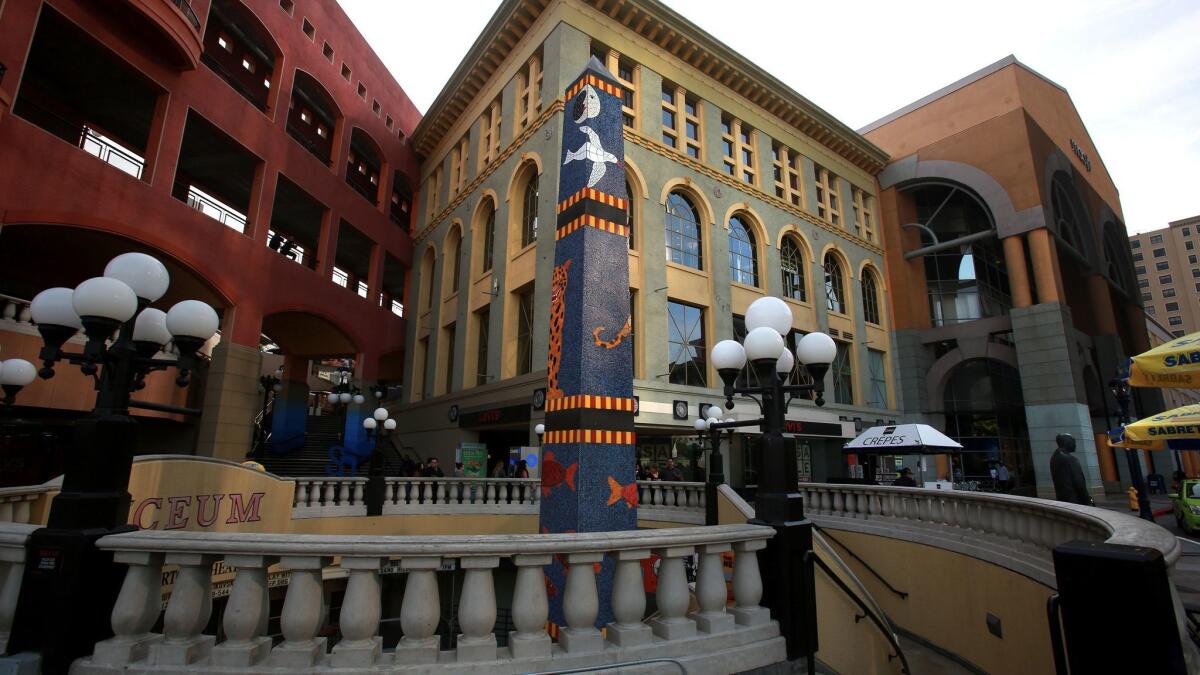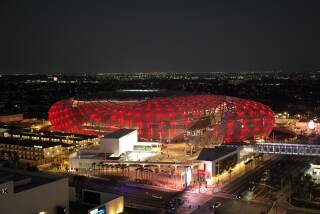San Diego’s aging Horton Plaza, once a landmark of urban design, is losing luster and tenants

- Share via
The late author Ray Bradbury imagined humans living on Mars, “firemen” on a mission to burn books — and a radical attempt to reshape downtown San Diego.
In his 1970s essay, “The Aesthetics of Lostness,” the Los Angeles science fiction writer extolled the joys of exploring safe yet stimulating urban streets.
“The premise behind the essay,” Bradbury reflected shortly before his death in 2012, “was building a city where people could spend an afternoon, getting safely lost, just wandering about. Jon Jerde built Horton Plaza in downtown San Diego using my essay as his touchstone.”
A landmark of urban design and a turning point in San Diego’s history, Horton Plaza opened in August 1985. This collaborative effort drew on the talents of Jerde, the architect; Ernest Hahn, the developer; a gaggle of city planners, politicians, activists and gadflies; and even Bradbury, the author of “Fahrenheit 451.”
Today, mired in a midlife crisis, Horton Plaza seems to have lost its sparkle. The mall is bleeding tenants: Nordstrom packed its Coach bags last year; Panda Inn, Horton Plaza’s last full-service restaurant, departs Jan. 31. Besides empty storefronts, visitors wandering the five-story, 900,000-square-foot complex see peeling paint, chipped tiles and cracked woodwork.
Westfield, Horton Plaza’s Australian owner, has promised a “future revitalization” of this property but has released no details.
Malls around the world face daunting challenges, as online stores siphon off consumers. For busy shoppers, Horton Plaza presents an additional drawback: its trademark design of meandering walkways.
“I’m now retired — I have two hours to wander around and find out where the hell the escalator is,” said the Rev. Joe Carroll, a Horton Plaza regular. “But there’s not a lot of people today who want to do this.”
Since the 1950s, American shopping malls — like American residential developments — had been focused on the suburbs. Left behind were inner cities, including San Diego’s.
“Downtown was definitely a collection of porn shops and peep shows. There was no reason to come here,” said Sam Woodhouse, artistic director of the San Diego Repertory Theatre, part of Horton Plaza since 1986.
Even with a new attraction, could downtown entice suburban residents to drive past closer malls, then shop in an area surrounded by an entrenched homeless population? It was a critical question, as Horton Plaza’s success initially depended on its ability to woo shoppers from the suburbs.
“Back around then, there were only 13,000 people living downtown,” said Gary Smith, president of the Downtown San Diego Residents Group. “How on earth would downtown support a shopping center?”
The opening of Horton Plaza in 1985 coincided with a campaign to clean up the surrounding Gaslamp Quarter.
In its first year, the shopping center drew 25 million visitors. This mall — and, with it, downtown San Diego — had arrived on the national map.
“This city has desperately needed a town square,” architecture critic Paul Goldberger wrote in the New York Times, “and now it has one.”
Jerde’s “wildly exuberant” design owed almost as much to Disneyland as Italian hill towns, Goldberger noted.
“It is best described as a conventional shopping mall on a stage set for an Italian hill town, a mix of turrets and colonnades and terraces and towers, all in tones of peach and apricot and rose and ochre,” the critic wrote.
“It is entered by a grand staircase, and its main walkway twists and turns to create constantly changing vistas.”
Horton Plaza quickly became a San Diego must-see, along with Balboa Park, the San Diego Zoo and SeaWorld.
“The first trolley line went in at the same time,” said Smith, leader of the Downtown San Diego Residents Group, “and huge numbers of people rode the trolley up to shop at Horton Plaza.”
Drivers who traveled to the mall discovered another of its quirks: the parking garage. There are two connected garages, actually, with levels associated with fruits or vegetables — 5 Tomato, say. Moreover, parking levels do not correspond to mall levels. Someone on the mall’s fifth level, for instance, needs to walk downstairs to reach the garage’s sixth floor.
And then there’s the hodgepodge of parking rates. Today, parking is free for one hour, and each succeeding 15 minutes is $2. Unless you enter after 8 p.m. and leave before 5 a.m., when the flat rate is $10. Unless it’s Thursday, Friday or Saturday, when the overnight flat rate is $20.
At suburban malls, parking is free. Being downtown, surrounded by parking lots that charge $10, $20 or more, Horton Plaza doesn’t have that option.
“People hate to come there and pay for parking to shop,” Smith said. “But if you do have free parking, you’d be packed solid in five minutes.”
If Horton Plaza’s future as a retail center is uncertain, its position among urban planners seems secure. From MIT to Turkey’s Çankaya University, Jerde’s “experience architecture” is cited as a textbook example of how malls can revive sagging urban cores.
“Horton Plaza,” Turkish planner Buket Ergun Kocaili wrote in her 2010 master’s degree thesis, “redefined the urban retail experience and served as a catalyst for regeneration of the downtown.”
This catalyst also boosted Jerde’s career, whose work on Horton Plaza helped secure his position as the architect of the 1984 Los Angeles Olympics. He died in 2015 at the age of 75, leaving behind a long roster of landmark projects, from L.A.’s Universal CityWalk (1993) to Tokyo’s Roppongi Hills (2002).
Horton Plaza’s theatricality, its sense of play and discovery are echoed by developments in the L.A. area, Americana at Brand and the Grove, said Andrea Pavia, a consultant with Steer Davies Gleave, an urban design firm in Los Angeles. They are brick-and-mortar rebuttals to the argument that the future belongs to online shopping.
Moreover, city living is experiencing a renaissance. Downtown San Diego now has an estimated 38,000 residents, almost triple what the population was when Horton Plaza opened. Urban malls, Pavia said, can cater to local residents plus others who enjoy shopping in a unique setting.
“We are seeking more and more experiences and surprise,” he said, “a journey in our life.”
This may not be an American view, acknowledged Pavia, who grew up in Rome. The eternal city, he said, “is built on layers of history.”
If Horton Plaza must be remodeled, Pavia hopes the spirit of Jerde’s Italian-inspired design will be preserved.
“For me,” he said, “that’s an opportunity to build on a layer of your city, like in Rome.”
Rowe writes for the San Diego Union-Tribune.
More to Read
Sign up for Essential California
The most important California stories and recommendations in your inbox every morning.
You may occasionally receive promotional content from the Los Angeles Times.










